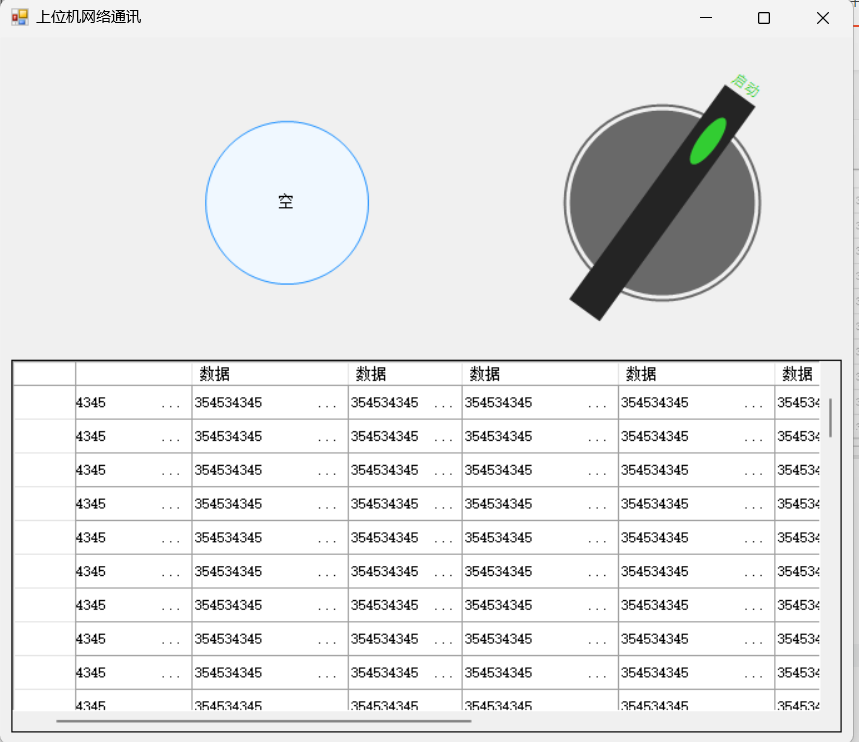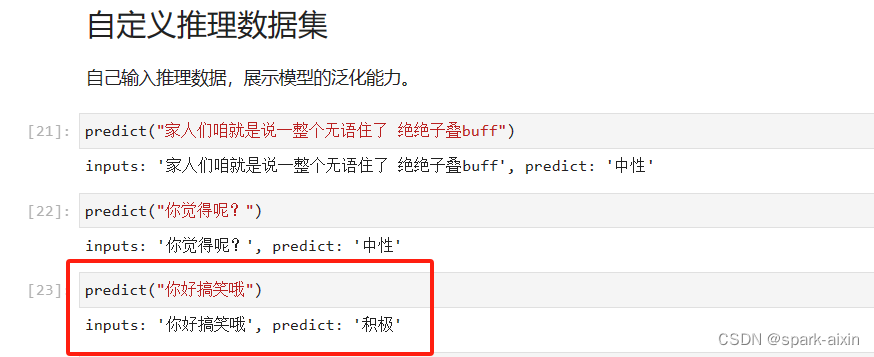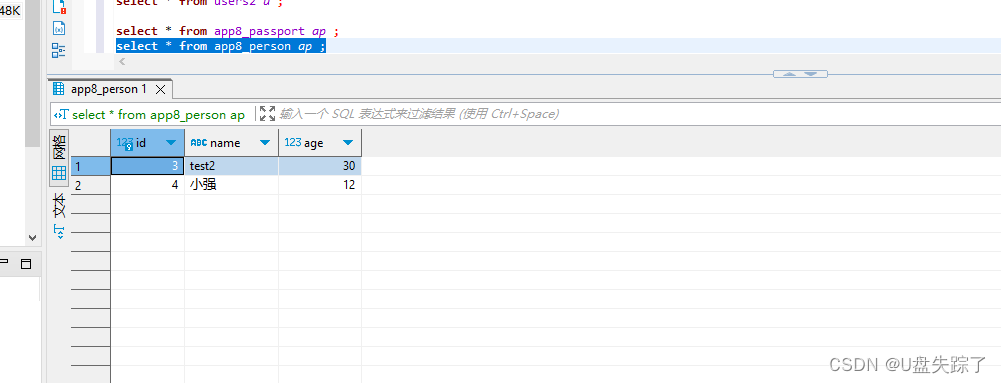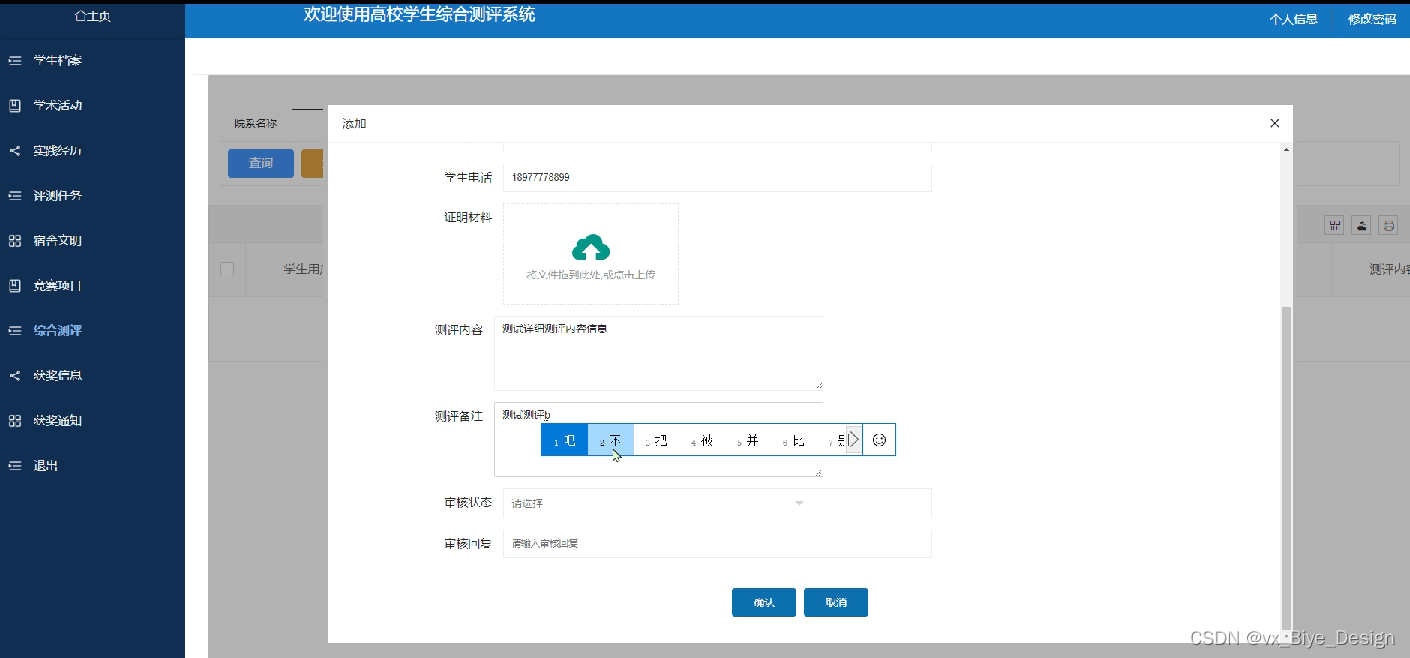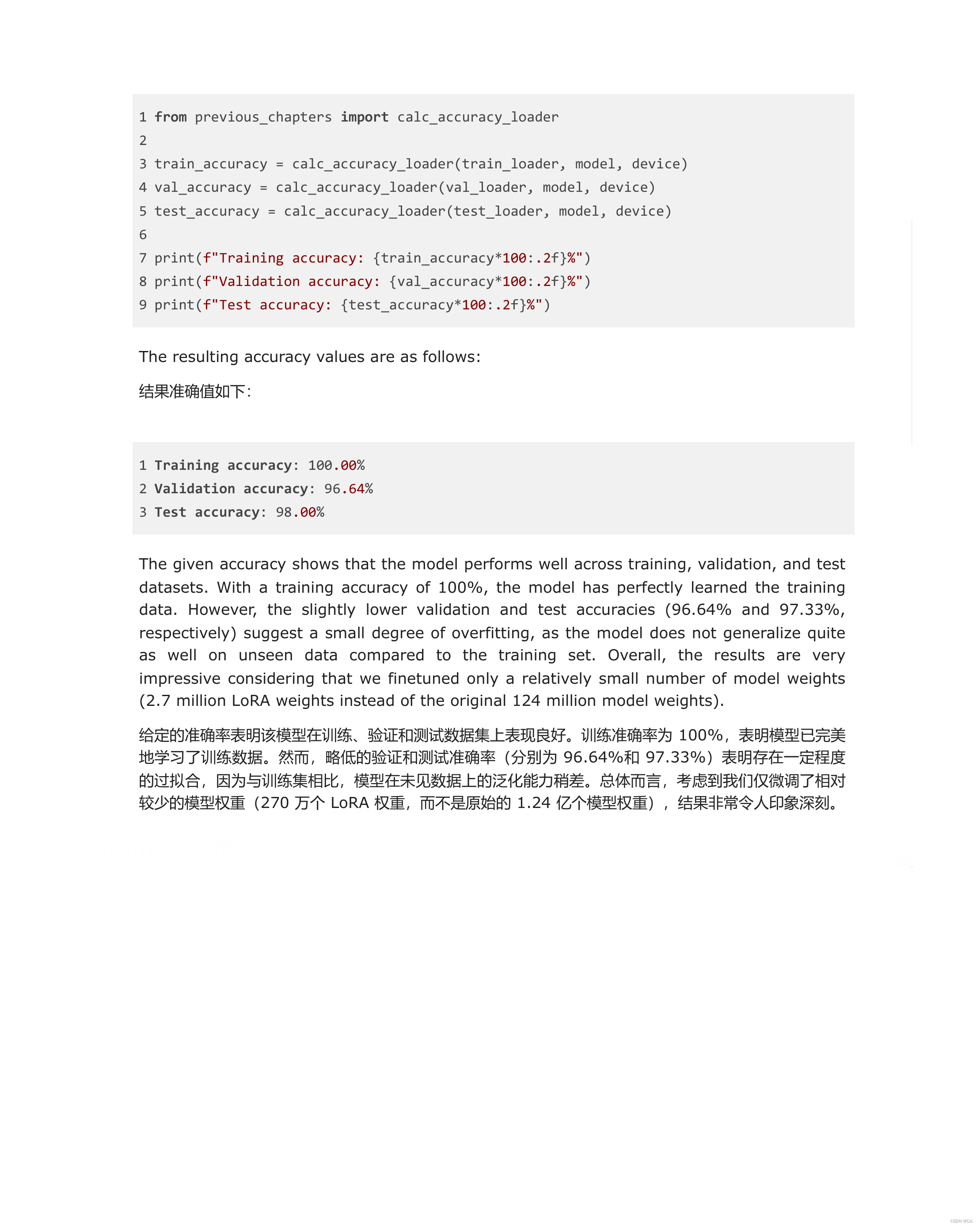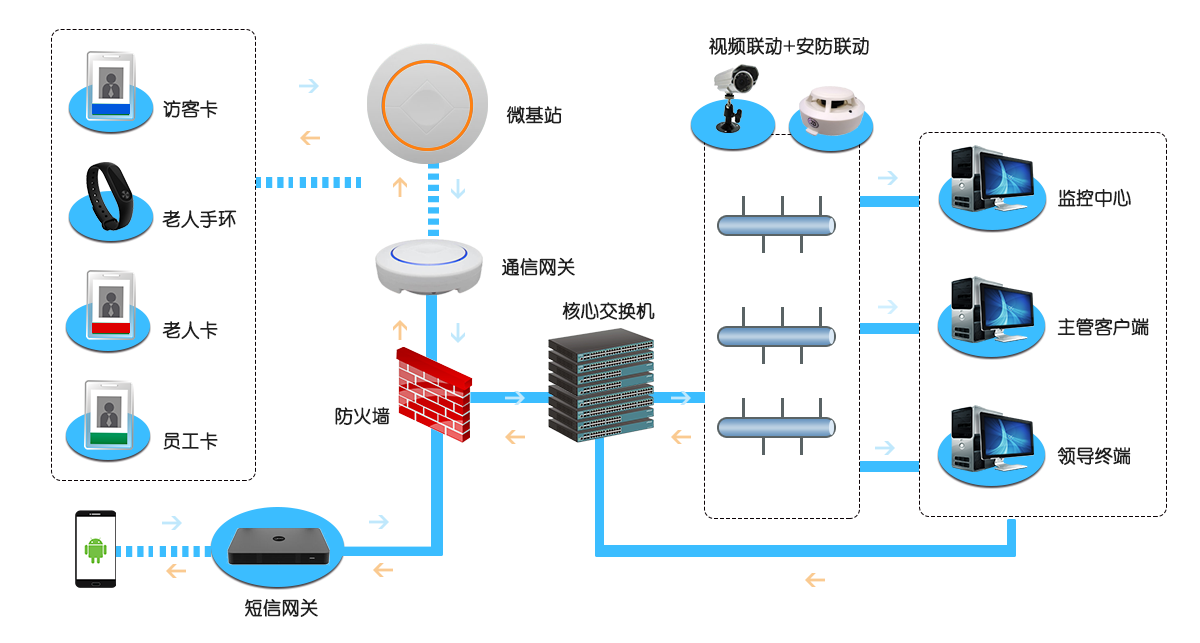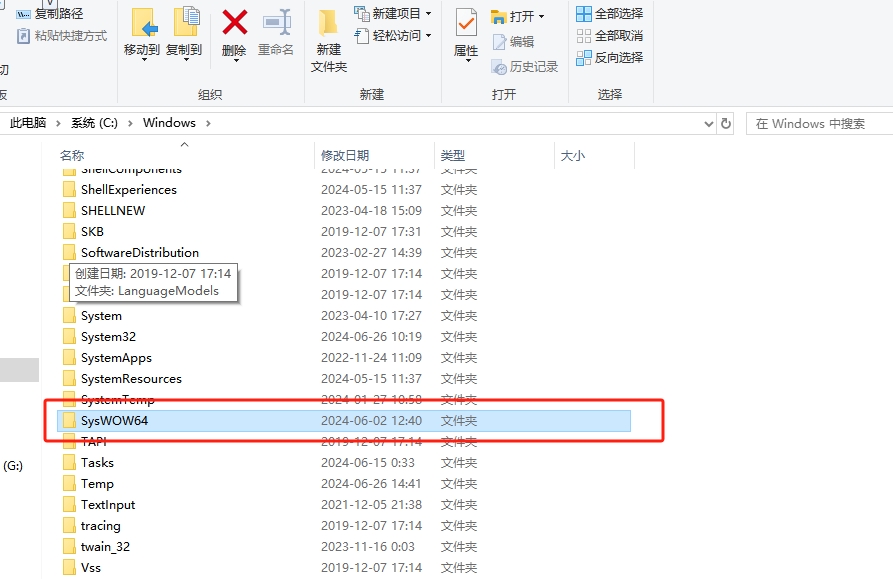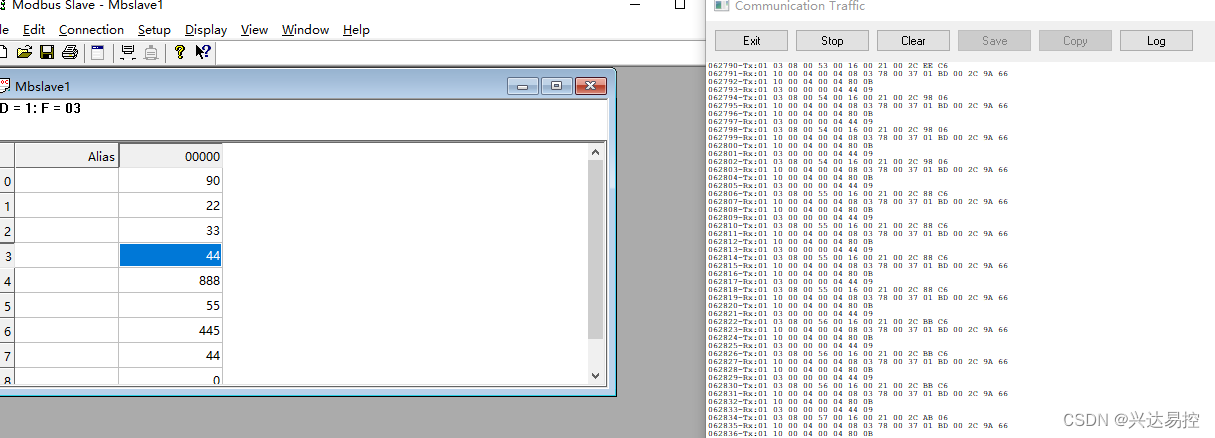文章目录
- 1. 概述
- 2. 单向链表
- 3. 单向链表(带哨兵)
- 4. 双向链表(带哨兵)
- 5. 环形链表(带哨兵)
- 6. 习题
- E01. 反转单向链表-Leetcode 206
- E02. 根据值删除节点-Leetcode 203
- E03. 两数相加-Leetcode 2
- E04. 删除倒数节点-Leetcode 19
- E05. 有序链表去重-Leetcode 83
- E06. 有序链表去重-Leetcode 82
- E07. 合并有序链表-Leetcode 21
- E08. 合并多个有序链表-Leetcode 23
- E09. 查找链表中间节点-Leetcode 876
- E10. 回文链表-Leetcode 234
- E11. 环形链表-Leetcode 141
- E12. 环形链表-Leetcode 142
- E13. 共尾链表-Leetcode 160
1. 概述
定义
在计算机科学中,链表是数据元素的线性集合,其每个元素都指向下一个元素,元素存储上并不连续
In computer science, a linked list is a linear collection of data elements whose order is not given by their physical placement in memory. Instead, each element points to the next.
可以分类为
- 单向链表,每个元素只知道其下一个元素是谁

- 双向链表,每个元素知道其上一个元素和下一个元素

- 循环链表,通常的链表尾节点 tail 指向的都是 null,而循环链表的 tail 指向的是头节点 head

链表内还有一种特殊的节点称为哨兵(Sentinel)节点,也叫做哑元( Dummy)节点,它不存储数据,通常用作头尾,用来简化边界判断,如下图所示

随机访问性能
根据 index 查找,时间复杂度 O ( n ) O(n) O(n)
插入或删除性能
- 起始位置: O ( 1 ) O(1) O(1)
- 结束位置:如果已知 tail 尾节点是 O ( 1 ) O(1) O(1),不知道 tail 尾节点是 O ( n ) O(n) O(n)
- 中间位置:根据 index 查找时间 + O ( 1 ) O(1) O(1)
2. 单向链表
根据单向链表的定义,首先定义一个存储 value 和 next 指针的类 Node,和一个描述头部节点的引用
public class SinglyLinkedList {private Node head; // 头部节点private static class Node { // 节点类int value;Node next;public Node(int value, Node next) {this.value = value;this.next = next;}}
}
- Node 定义为内部类,是为了对外隐藏实现细节,没必要让类的使用者关心 Node 结构
- 定义为 static 内部类,是因为 Node 不需要与 SinglyLinkedList 实例相关,多个 SinglyLinkedList实例能共用 Node 类定义
头部添加
public class SinglyLinkedList {// ...public void addFirst(int value) {this.head = new Node(value, this.head);}
}
- 如果 this.head == null,新增节点指向 null,并作为新的 this.head
- 如果 this.head != null,新增节点指向原来的 this.head,并作为新的 this.head
- 注意赋值操作执行顺序是从右到左
while 遍历
public class SinglyLinkedList {// ...public void loop() {Node curr = this.head;while (curr != null) {// 做一些事curr = curr.next;}}
}
for 遍历
public class SinglyLinkedList {// ...public void loop() {for (Node curr = this.head; curr != null; curr = curr.next) {// 做一些事}}
}
- 以上两种遍历都可以把要做的事以 Consumer 函数的方式传递进来
- Consumer 的规则是一个参数,无返回值,因此像 System.out::println 方法等都是 Consumer
- 调用 Consumer 时,将当前节点 curr.value 作为参数传递给它
/*** 遍历链表1** @param consumer 要执行的操作*/public void loop1(Consumer<Integer> consumer) {Node p = head;while (p != null) {consumer.accept(p.value);p = p.next;}}/*** 遍历链表2** @param consumer 要执行的操作*/public void loop2(Consumer<Integer> consumer) {for (Node p = head; p != null; p = p.next) {consumer.accept(p.value);}}public class TestSinglyLinkedList {private SinglyLinkedList getLinkedList() {SinglyLinkedList list = new SinglyLinkedList();list.addLast(1);list.addLast(2);list.addLast(3);list.addLast(4);return list;}@Test@DisplayName("测试while遍历")public void test001() {SinglyLinkedList list = getLinkedList();list.loop1(value -> {System.out.println("while:" + value);});}@Test@DisplayName("测试for遍历")public void test002() {SinglyLinkedList list = getLinkedList();list.loop1(value -> {System.out.println("for:" + value);});}}
迭代器遍历
public class SinglyLinkedList implements Iterable<Integer> {// ...private class NodeIterator implements Iterator<Integer> {Node curr = head;public boolean hasNext() {return curr != null;}public Integer next() {int value = curr.value;curr = curr.next;return value;}}public Iterator<Integer> iterator() {return new NodeIterator();}
}
- hasNext 用来判断是否还有必要调用 next
- next 做两件事
- 返回当前节点的 value
- 指向下一个节点
NodeIterator要定义为非 static 内部类,是因为它与SinglyLinkedList实例相关,是对某个SinglyLinkedList实例的迭代
递归遍历
public class SinglyLinkedList implements Iterable<Integer> {// 递归1public void loop() {recursion(this.head);}private void recursion(Node curr) {if (curr == null) {return;}// 前面做些事recursion(curr.next);// 后面做些事}// 递归2public void loop3(Consumer<Integer> before,Consumer<Integer> after) {recursion(head, before, after);}private void recursion(Node curr,Consumer<Integer> before, Consumer<Integer> after) { // 某个节点要进行的操作if (curr == null) {return;}before.accept(curr.value);recursion(curr.next, before, after);after.accept(curr.value);}}
public class TestSinglyLinkedList {@Test@DisplayName("测试递归遍历")public void test() {SinglyLinkedList list = getLinkedList();list.loop3(value -> {System.out.println("before:" + value);}, value -> {System.out.println("after:" + value);});}}
结果
已连接到地址为 ''127.0.0.1:9477',传输: '套接字'' 的目标虚拟机
before:1
before:2
before:3
before:4
after:4
after:3
after:2
after:1
已与地址为 ''127.0.0.1:9477',传输: '套接字'' 的目标虚拟机断开连接进程已结束,退出代码为 0尾部添加
public class SinglyLinkedList {// ...private Node findLast() {if (this.head == null) {return null;}Node curr;for (curr = this.head; curr.next != null; ) {curr = curr.next;}return curr;}public void addLast(int value) {Node last = findLast();if (last == null) {addFirst(value);return;}last.next = new Node(value, null);}
}
- 注意,找最后一个节点,终止条件是 curr.next == null
- 分成两个方法是为了代码清晰,而且 findLast() 之后还能复用
尾部添加多个
public class SinglyLinkedList {// ...public void addLast(int first, int... rest) {Node sublist = new Node(first, null);Node curr = sublist;for (int value : rest) {curr.next = new Node(value, null);curr = curr.next;}Node last = findLast();if (last == null) {this.head = sublist;return;}last.next = sublist;}
}
- 先串成一串 sublist
- 再作为一个整体添加
根据索引获取
public class SinglyLinkedList {// ...private Node findNode(int index) {int i = 0;for (Node curr = this.head; curr != null; curr = curr.next, i++) {if (index == i) {return curr;}}return null;}private IllegalArgumentException illegalIndex(int index) {return new IllegalArgumentException(String.format("index [%d] 不合法%n", index));}public int get(int index) {Node node = findNode(index);if (node != null) {return node.value;}throw illegalIndex(index);}
}
- 同样,分方法可以实现复用
插入
public class SinglyLinkedList {// ...public void insert(int index, int value) {if (index == 0) {addFirst(value);return;}Node prev = findNode(index - 1); // 找到上一个节点if (prev == null) { // 找不到throw illegalIndex(index);}prev.next = new Node(value, prev.next);}
}
- 插入包括下面的删除,都必须找到上一个节点
删除
public class SinglyLinkedList {// ...public void remove(int index) {if (index == 0) {if (this.head != null) {this.head = this.head.next;return;} else {throw illegalIndex(index);}}Node prev = findNode(index - 1);Node curr;if (prev != null && (curr = prev.next) != null) {prev.next = curr.next;} else {throw illegalIndex(index);}}
}
- 第一个 if 块对应着 removeFirst 情况
- 最后一个 if 块对应着至少得两个节点的情况
- 不仅仅判断上一个节点非空,还要保证当前节点非空
3. 单向链表(带哨兵)
观察之前单向链表的实现,发现每个方法内几乎都有判断是不是 head 这样的代码,能不能简化呢?
用一个不参与数据存储的特殊 Node 作为哨兵,它一般被称为哨兵或哑元,拥有哨兵节点的链表称为带头链表
public class SinglyLinkedListSentinel {// ...private Node head = new Node(Integer.MIN_VALUE, null);
}
- 具体存什么值无所谓,因为不会用到它的值
加入哨兵节点后,代码会变得比较简单,先看几个工具方法
public class SinglyLinkedListSentinel {// ...// 根据索引获取节点private Node findNode(int index) {int i = -1;for (Node curr = this.head; curr != null; curr = curr.next, i++) {if (i == index) {return curr;}}return null;}// 获取最后一个节点private Node findLast() {Node curr;for (curr = this.head; curr.next != null; ) {curr = curr.next;}return curr;}
}
- findNode 与之前类似,只是 i 初始值设置为 -1 对应哨兵,实际传入的 index 也是 [ − 1 , ∞ ) [-1, \infty) [−1,∞)
- findLast 绝不会返回 null 了,就算没有其它节点,也会返回哨兵作为最后一个节点
这样,代码简化为
public class SinglyLinkedListSentinel {// ...public void addLast(int value) {Node last = findLast();/*改动前if (last == null) {this.head = new Node(value, null);return;}*/last.next = new Node(value, null);}public void insert(int index, int value) {/*改动前if (index == 0) {this.head = new Node(value, this.head);return;}*/// index 传入 0 时,返回的是哨兵Node prev = findNode(index - 1);if (prev != null) {prev.next = new Node(value, prev.next);} else {throw illegalIndex(index);}}public void remove(int index) {/*改动前if (index == 0) {if (this.head != null) {this.head = this.head.next;return;} else {throw illegalIndex(index);}}*/// index 传入 0 时,返回的是哨兵Node prev = findNode(index - 1);Node curr;if (prev != null && (curr = prev.next) != null) {prev.next = curr.next;} else {throw illegalIndex(index);}}public void addFirst(int value) {/*改动前this.head = new Node(value, this.head);*/this.head.next = new Node(value, this.head.next);// 也可以视为 insert 的特例, 即 insert(0, value);}
}
- 对于删除,前面说了【最后一个 if 块对应着至少得两个节点的情况】,现在有了哨兵,就凑足了两个节点
4. 双向链表(带哨兵)
public class DoublyLinkedListSentinel implements Iterable<Integer> {private final Node head;private final Node tail;public DoublyLinkedListSentinel() {head = new Node(null, 666, null);tail = new Node(null, 888, null);head.next = tail;tail.prev = head;}private Node findNode(int index) {int i = -1;for (Node p = head; p != tail; p = p.next, i++) {if (i == index) {return p;}}return null;}public void addFirst(int value) {insert(0, value);}public void removeFirst() {remove(0);}public void addLast(int value) {Node prev = tail.prev;Node added = new Node(prev, value, tail);prev.next = added;tail.prev = added;}public void removeLast() {Node removed = tail.prev;if (removed == head) {throw illegalIndex(0);}Node prev = removed.prev;prev.next = tail;tail.prev = prev;}public void insert(int index, int value) {Node prev = findNode(index - 1);if (prev == null) {throw illegalIndex(index);}Node next = prev.next;Node inserted = new Node(prev, value, next);prev.next = inserted;next.prev = inserted;}public void remove(int index) {Node prev = findNode(index - 1);if (prev == null) {throw illegalIndex(index);}Node removed = prev.next;if (removed == tail) {throw illegalIndex(index);}Node next = removed.next;prev.next = next;next.prev = prev;}private IllegalArgumentException illegalIndex(int index) {return new IllegalArgumentException(String.format("index [%d] 不合法%n", index));}@Overridepublic Iterator<Integer> iterator() {return new Iterator<Integer>() {Node p = head.next;@Overridepublic boolean hasNext() {return p != tail;}@Overridepublic Integer next() {int value = p.value;p = p.next;return value;}};}static class Node {Node prev;int value;Node next;public Node(Node prev, int value, Node next) {this.prev = prev;this.value = value;this.next = next;}}
}
5. 环形链表(带哨兵)
双向环形链表带哨兵,这时哨兵既作为头,也作为尾




参考实现
public class DoublyLinkedListSentinel implements Iterable<Integer> {@Overridepublic Iterator<Integer> iterator() {return new Iterator<>() {Node p = sentinel.next;@Overridepublic boolean hasNext() {return p != sentinel;}@Overridepublic Integer next() {int value = p.value;p = p.next;return value;}};}static class Node {Node prev;int value;Node next;public Node(Node prev, int value, Node next) {this.prev = prev;this.value = value;this.next = next;}}private final Node sentinel = new Node(null, -1, null); // 哨兵public DoublyLinkedListSentinel() {sentinel.next = sentinel;sentinel.prev = sentinel;}/*** 添加到第一个* @param value 待添加值*/public void addFirst(int value) {Node next = sentinel.next;Node prev = sentinel;Node added = new Node(prev, value, next);prev.next = added;next.prev = added;}/*** 添加到最后一个* @param value 待添加值*/public void addLast(int value) {Node prev = sentinel.prev;Node next = sentinel;Node added = new Node(prev, value, next);prev.next = added;next.prev = added;}/*** 删除第一个*/public void removeFirst() {Node removed = sentinel.next;if (removed == sentinel) {throw new IllegalArgumentException("非法");}Node a = sentinel;Node b = removed.next;a.next = b;b.prev = a;}/*** 删除最后一个*/public void removeLast() {Node removed = sentinel.prev;if (removed == sentinel) {throw new IllegalArgumentException("非法");}Node a = removed.prev;Node b = sentinel;a.next = b;b.prev = a;}/*** 根据值删除节点* <p>假定 value 在链表中作为 key, 有唯一性</p>* @param value 待删除值*/public void removeByValue(int value) {Node removed = findNodeByValue(value);if (removed != null) {Node prev = removed.prev;Node next = removed.next;prev.next = next;next.prev = prev;}}private Node findNodeByValue(int value) {Node p = sentinel.next;while (p != sentinel) {if (p.value == value) {return p;}p = p.next;}return null;}}
6. 习题
E01. 反转单向链表-Leetcode 206
输入:head = [1,2,3,4,5]
输出:[5,4,3,2,1]输入:[1,2]
输出:[2,1]输入:[]
输出:[]
方法1
构造一个新链表,从旧链表依次拿到每个节点,创建新节点添加至新链表头部,完成后新链表即是倒序的
public ListNode reverseList(ListNode o1) {ListNode n1 = null;ListNode p = o1;while (p != null) {n1 = new ListNode(p.val, n1);p = p.next;}return n1;
}
评价:简单直白,就是得新创建节点对象
方法2
与方法1 类似,构造一个新链表,从旧链表头部移除节点,添加到新链表头部,完成后新链表即是倒序的,区别在于原题目未提供节点外层的容器类,这里提供一个,另外一个区别是并不去构造新节点
static class List {ListNode head;public List(ListNode head) {this.head = head;}public ListNode removeFirst(){ListNode first = head;if (first != null) {head = first.next;}return first;}public void addFirst(ListNode first) {first.next = head;head = first;}
}
代码
public ListNode reverseList(ListNode head) {List list1 = new List(head);List list2 = new List(null);ListNode first;while ((first = list1.removeFirst()) != null) {list2.addFirst(first);}return list2.head;
}
评价:更加面向对象,如果实际写代码而非刷题,更多会这么做
方法3
递归,在归时让 5 → 4 5 \rightarrow 4 5→4, 4 → 3 4 \rightarrow 3 4→3 …
首先,写一个递归方法,返回值用来拿到最后一个节点
public ListNode reverseList(ListNode p) {if (p == null || p.next == null) { // 不足两个节点return p; // 最后一个节点}ListNode last = reverseList(p.next);return last;
}
- 注意1:递归终止条件是 curr.next == null,目的是到最后一个节点就结束递归,与之前递归遍历不一样
- 注意2:需要考虑空链表即 p == null 的情况
可以先测试一下
ListNode o5 = new ListNode(5, null);
ListNode o4 = new ListNode(4, o5);
ListNode o3 = new ListNode(3, o4);
ListNode o2 = new ListNode(2, o3);
ListNode o1 = new ListNode(1, o2);
ListNode n1 = new E01Leetcode206().reverseList(o1);
System.out.println(n1);
会打印
[5]
下面为伪码调用过程,假设节点分别是 1 → 2 → 3 → 4 → 5 → n u l l 1 \rightarrow 2 \rightarrow 3 \rightarrow 4 \rightarrow 5 \rightarrow null 1→2→3→4→5→null,先忽略返回值
reverseList(ListNode p = 1) {reverseList(ListNode p = 2) {reverseList(ListNode p = 3) {reverseList(ListNode p = 4) {reverseList(ListNode p = 5) {if (p == null || p.next == null) {return p; // 返回5}}// 此时p是4, p.next是5}// 此时p是3, p.next是4}// 此时p是2, p.next是3}// 此时p是1, p.next是2
}
接下来,从 p = 4 开始,要让 5 → 4 5 \rightarrow 4 5→4, 4 → 3 4 \rightarrow 3 4→3 …
reverseList(ListNode p = 1) {reverseList(ListNode p = 2) {reverseList(ListNode p = 3) {reverseList(ListNode p = 4) {reverseList(ListNode p = 5) {if (p == null || p.next == null) {return p; // 返回5}}// 此时p是4, p.next是5, 要让5指向4,代码写成 p.next.next=p// 还要注意4要指向 null, 否则就死链了}// 此时p是3, p.next是4}// 此时p是2, p.next是3}// 此时p是1, p.next是2
}
动画演示:


最终代码为:
public ListNode reverseList(ListNode p) { if (p == null || p.next == null) { // 不足两个节点return p; // 最后一个节点}ListNode last = reverseList(p.next);p.next.next = p;p.next = null;return last;
}
Q:为啥不能在递的过程中倒序?
A:比如
- 1 → 2 → 3 1 \rightarrow 2 \rightarrow 3 1→2→3 如果递的过程中让 2→1 那么此时2→3就被覆盖,不知道接下来递给谁
- 而归的时候让 3→2 不会影响上一层的 1→2
评价:单向链表没有 prev 指针,但利用递归的特性【记住了】链表每次调用时相邻两个节点是谁
方法4
从链表每次拿到第二个节点,将其从链表断开,插入头部,直至它为 null 结束
设置指针 o1(旧头)、n1(新头)、o2(旧老二),分别指向第一,第一,第二节点 n 1 o 1 1 → o 2 2 → 3 → 4 → 5 → n u l l \frac{n1 \ o1}{1} \rightarrow \frac{o2}{2} \rightarrow 3 \rightarrow 4 \rightarrow 5 \rightarrow null 1n1 o1→2o2→3→4→5→null
将 o2 节点从链表断开,即 o1 节点指向第三节点 n 1 o 1 1 → 3 → 4 → 5 → n u l l \frac{n1 \ o1}{1} \rightarrow 3 \rightarrow 4 \rightarrow 5 \rightarrow null 1n1 o1→3→4→5→null , o 2 2 \frac{o2}{2} 2o2
o2 节点链入链表头部,即 o 2 2 → n 1 o 1 1 → 3 → 4 → 5 → n u l l \frac{o2}{2} \rightarrow \frac{n1 \ o1}{1} \rightarrow 3 \rightarrow 4 \rightarrow 5 \rightarrow null 2o2→1n1 o1→3→4→5→null
n1 指向 o2 n 1 o 2 2 → o 1 1 → 3 → 4 → 5 → n u l l \frac{n1 \ o2}{2} \rightarrow \frac{o1}{1} \rightarrow 3 \rightarrow 4 \rightarrow 5 \rightarrow null 2n1 o2→1o1→3→4→5→null
o2 指向 o1 的下一个节点,即 n 1 2 → o 1 1 → o 2 3 → 4 → 5 → n u l l \frac{n1}{2} \rightarrow \frac{o1}{1} \rightarrow \frac{o2}{3} \rightarrow 4 \rightarrow 5 \rightarrow null 2n1→1o1→3o2→4→5→null
重复以上 2∼5步,直到 o2 指向 null
还应当考虑边界条件,即链表中不满两个元素时,无需走以上逻辑
动图:

动画演示中其实省略了一个tmp变量,这个tmp变量会将cur的下一个节点保存起来,考虑到一张动画放太多变量会很混乱,所以我就没加了,具体详细执行过程,请点击下面的幻灯片查看。

参考答案
public ListNode reverseList(ListNode o1) { if (o1 == null || o1.next == null) { // 不足两个节点return o1;}ListNode o2 = o1.next;ListNode n1 = o1;while (o2 != null) {o1.next = o2.next; o2.next = n1;n1 = o2;o2 = o1.next;}return n1;
}
E02. 根据值删除节点-Leetcode 203
例如
输入:head = [1,2,6,3,6], val = 6
输出:[1,2,3]输入:head = [], val = 1
输出:[]输入:head = [7,7,7,7], val = 7
输出:[]
方法1
public ListNode removeElements(ListNode head, int val) {ListNode sentinel = new ListNode(-1, head);ListNode p1 = sentinel;ListNode p2;while ((p2 = p1.next) != null) {if (p2.val == val) {p1.next = p2.next;} else {p1 = p1.next;}}return sentinel.next;
}
方法2
递归图解

代码:
class Solution {public ListNode removeElements(ListNode head, int val) {if(head==null)return null;head.next=removeElements(head.next,val);if(head.val==val){return head.next;}else{return head;}}
}E03. 两数相加-Leetcode 2
例如
输入:l1 = [2,4,3], l2 = [5,6,4]
输出:[7,0,8]
解释:342 + 465 = 807.输入:l1 = [0], l2 = [0]
输出:[0]输入:l1 = [9,9,9,9,9,9,9], l2 = [9,9,9,9]
输出:[8,9,9,9,0,0,0,1]
思路:
- 将两个链表看成是相同长度的进行遍历,如果一个链表较短则在前面补 000,比如 987 + 23 = 987 + 023 = 1010
- 每一位计算的同时需要考虑上一位的进位问题,而当前位计算结束后同样需要更新进位值
- 如果两个链表全部遍历完毕后,进位值为 111,则在新链表最前方添加节点 111
- 小技巧:对于链表问题,返回结果为头结点时,通常需要先初始化一个预先指针 pre,该指针的下一个节点指向真正的头结点 head。使用预先指针的目的在于链表初始化时无可用节点值,而且链表构造过程需要指针移动,进而会导致头指针丢失,无法返回结果。
图解:

代码
/*** Definition for singly-linked list.* public class ListNode {* int val;* ListNode next;* ListNode(int x) { val = x; }* }*/
class Solution {public ListNode addTwoNumbers(ListNode l1, ListNode l2) {ListNode pre = new ListNode(0);ListNode cur = pre;int carry = 0;while(l1 != null || l2 != null) {int x = l1 == null ? 0 : l1.val;int y = l2 == null ? 0 : l2.val;int sum = x + y + carry;carry = sum / 10;sum = sum % 10;cur.next = new ListNode(sum);cur = cur.next;if(l1 != null)l1 = l1.next;if(l2 != null)l2 = l2.next;}if(carry == 1) {cur.next = new ListNode(carry);}return pre.next;}
}E04. 删除倒数节点-Leetcode 19
例如
输入:head = [1,2,3,4,5], n = 2
输出:[1,2,3,5]输入:head = [1], n = 1
输出:[]输入:head = [1,2], n = 1
输出:[1]
解题思路:
- 整体思路是让前面的指针先移动 n 步,之后前后指针共同移动直到前面的指针到尾部为止
- 首先设立预先指针 pre,预先指针是一个小技巧,在第 2 题中进行了讲解
- 设预先指针 pre 的下一个节点指向 head,设前指针为 start,后指针为 end,二者都等于 pre
- start 先向前移动n步
- 之后 start 和 end 共同向前移动,此时二者的距离为 n,当 start 到尾部时,end 的位置恰好为倒数第 n 个节点
- 因为要删除该节点,所以要移动到该节点的前一个才能删除,所以循环结束条件为 start.next != null
- 删除后返回 pre.next,为什么不直接返回 head 呢,因为 head 有可能是被删掉的点
- 时间复杂度:O(n)O(n)O(n)
画解

代码
/*** Definition for singly-linked list.* public class ListNode {* int val;* ListNode next;* ListNode() {}* ListNode(int val) { this.val = val; }* ListNode(int val, ListNode next) { this.val = val; this.next = next; }* }*/
class Solution {//通过快慢指针来解决,类似于你要删除中间元素的题public ListNode removeNthFromEnd(ListNode head, int n) {//定义一个伪节点,用于返回结果ListNode dumpy = new ListNode(0);dumpy.next = head;//定义一个快指针,指向伪节点,用于遍历链表ListNode prev = dumpy;//定一个慢指针,ListNode tail = dumpy;//让快指针先移动 n 步while(n >0){prev = prev.next;n--;}//只要快指针不指向空,就继续循环while(prev.next !=null){//让快慢指针同时移动tail = tail.next;prev = prev.next;}//这时慢指针移动到的位置就是,要删除节点的前一个节点//所以只要删除当前节点的下一个节点tail.next = tail.next.next;//返回为指针指向的头节点return dumpy.next;}
}
E05. 有序链表去重-Leetcode 83
例如
输入:head = [1,1,2]
输出:[1,2]输入:head = [1,1,2,3,3]
输出:[1,2,3]
注意:重复元素保留一个
方法1
- 指定 cur 指针指向头部 head
- 当 cur 和 cur.next 的存在为循环结束条件,当二者有一个不存在时说明链表没有去重复的必要了
- 当 cur.val 和 cur.next.val 相等时说明需要去重,则将 cur 的下一个指针指向下一个的下一个,这样就能达到去重复的效果
- 如果不相等则 cur 移动到下一个位置继续循环
- 时间复杂度:O(n)O(n)O(n)
图解:

代码
/*** Definition for singly-linked list.* public class ListNode {* int val;* ListNode next;* ListNode(int x) { val = x; }* }*/
class Solution {public ListNode deleteDuplicates(ListNode head) {ListNode cur = head;while(cur != null && cur.next != null) {if(cur.val == cur.next.val) {cur.next = cur.next.next;} else {cur = cur.next;}}return head;}
}
方法2
主要思想:
-
链表具有天然的递归性,链表看成其头节点后挂接一个更短的链表,这个更短的链表看成其头节点后面挂接一个更更短的链表,依次类推。
-
因此本题可以按照如下步骤处理:
-
删除更短链表中所有重复的元素;
-
判断原链表的头节点的值是否等于经过第 1 步处理后的更短链表头节点的值;
-
若相等,则返回更短的链表;
-
否则,将更短的链表挂接在原链表的头节点的后面,再返回。
-
边界条件
- 链表为空
- 链表只有一个节点(头节点)
代码:
class Solution {public ListNode deleteDuplicates(ListNode head) {if (null == head || null == head.next) {return head;}head.next = deleteDuplicates(head.next);return head.val == head.next.val ? head.next : head;}
}E06. 有序链表去重-Leetcode 82
例如
输入:head = [1,2,3,3,4,4,5]
输出:[1,2,5]输入:head = [1,1,1,2,3]
输出:[2,3]
注意:重复元素一个不留
方法1
- 递归函数负责返回:从当前节点(我)开始,完成去重的链表
- 若我与 next 重复,一直找到下一个不重复的节点,以它的返回结果为准
- 若我与 next 不重复,返回我,同时更新 next
代码
class Solution {public ListNode deleteDuplicates(ListNode head) {if (head == null || head.next == null) {return head;}if (head.val == head.next.val) {while (head != null && head.next != null && head.val == head.next.val) {head = head.next;}return deleteDuplicates(head.next);} else {head.next = deleteDuplicates(head.next);return head;}}
}
方法2
p1 是待删除的上一个节点,每次循环对比 p2、p3 的值
- 如果 p2 与 p3 的值重复,那么 p3 继续后移,直到找到与 p2 不重复的节点,p1 指向 p3 完成删除
- 如果 p2 与 p3 的值不重复,p1,p2,p3 向后平移一位,继续上面的操作
- p2 或 p3 为 null 退出循环
- p2 为 null 的情况,比如链表为 1 1 1 null
p1 p2 p3
s, 1, 1, 1, 2, 3, nullp1 p2 p3
s, 1, 1, 1, 2, 3, nullp1 p2 p3
s, 1, 1, 1, 2, 3, nullp1 p3
s, 2, 3, nullp1 p2 p3
s, 2, 3, nullp1 p2 p3
s, 2, 3, null
代码
/*** 删除链表中的重复元素。* <p>* 本方法通过创建一个虚拟节点s来简化链表操作,避免处理头节点为空或只有一个节点的特殊情况。* 使用三个指针p1, p2, p3来遍历链表,其中p1用于标记当前检查到的位置,p2和p3用于比较是否存在重复元素。* 如果发现重复元素,p1将直接指向重复元素后的第一个不重复元素,从而实现删除重复元素的功能。* <p>* 时间复杂度:O(n),其中n是链表中的节点数。需要遍历链表中的每个节点一次。* 空间复杂度:O(1),只需要常数的空间存储几个指针变量。** @param head 链表的头节点* @return 删除重复元素后的链表的头节点*/// 方法2public ListNode deleteDuplicates(ListNode head) {// 处理链表为空或只有一个节点的情况if (head == null || head.next == null) {return head;}// 创建一个虚拟节点s,将其next指向头节点,简化链表操作ListNode s = new ListNode(-1, head);ListNode p1 = s;ListNode p2, p3;// 使用三个指针遍历链表,p2和p3用于比较是否存在重复元素while ((p2 = p1.next) != null&& (p3 = p2.next) != null) {// 如果p2和p3的值相同,表示存在重复元素if (p2.val == p3.val) {// 移动p3直到找到第一个不重复的元素while ((p3 = p3.next) != null&& p3.val == p2.val) {}// 将p1的next指向不重复元素,实现删除重复元素的功能// p3 找到了不重复的值p1.next = p3;} else {// 如果p2和p3的值不同,移动p1到下一个位置p1 = p1.next;}}// 返回删除重复元素后的链表的头节点return s.next;}
E07. 合并有序链表-Leetcode 21
例如
输入:l1 = [1,2,4], l2 = [1,3,4]
输出:[1,1,2,3,4,4]输入:l1 = [], l2 = []
输出:[]输入:l1 = [], l2 = [0]
输出:[0]
方法1
- 谁小,把谁链给 p,p 和小的都向后平移一位
- 当 p1、p2 有一个为 null,退出循环,把不为 null 的链给 p
p1
1 3 8 9 nullp2
2 4 nullp
s null
代码
public ListNode mergeTwoLists(ListNode p1, ListNode p2) {ListNode s = new ListNode(-1, null);ListNode p = s;while (p1 != null && p2 != null) {if (p1.val < p2.val) {p.next = p1;p1 = p1.next;} else {p.next = p2;p2 = p2.next;}p = p.next;}if (p1 != null) {p.next = p1;}if (p2 != null) {p.next = p2;}return s.next;
}
- 可以自行验证例中后两种情况
方法2
递归函数应该返回
- 更小的那个链表节点,并把它剩余节点与另一个链表再次递归
- 返回之前,更新此节点的 next
递归主要想清楚一下几点
1.这个问题的子问题是什么。
2.当前层要干什么事情。
3.递归出口。
图解

代码
class Solution {public ListNode mergeTwoLists(ListNode l1, ListNode l2) {if (l1 == null) {return l2;}else if (l2 == null) {return l1;}else if (l1.val < l2.val) {l1.next = mergeTwoLists(l1.next, l2);return l1;}else {l2.next = mergeTwoLists(l1, l2.next);return l2;}}
}
E08. 合并多个有序链表-Leetcode 23
例如
输入:lists = [[1,4,5],[1,3,4],[2,6]]
输出:[1,1,2,3,4,4,5,6]
解释:链表数组如下:
[1->4->5,1->3->4,2->6
]
将它们合并到一个有序链表中得到。
1->1->2->3->4->4->5->6
方法1
利用堆做排序
合并两个链表我们可以用if-else做判断,但是k个链接,用if-else,这就没法写了。
这时候我们需要一种辅助数据结构-堆,有了堆这个数据结构,难度等级是困难的题目,瞬间变成简单了。
我们把三个链表一股脑的全放到堆里面
1->4->51->3->42->6
然后由堆根据节点的val自动排好序
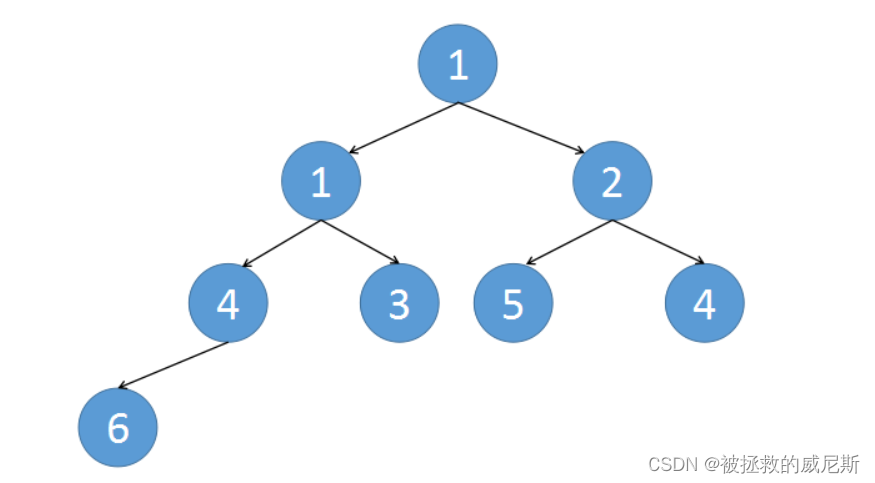
这是一个小根堆,我们只需要每次输出堆顶的元素,直到整个堆为空即可。
执行过程如下:

代码
class Solution {public ListNode mergeKLists(ListNode[] lists) {if(lists==null || lists.length==0) {return null;}//创建一个堆,并设置元素的排序方式PriorityQueue<ListNode> queue = new PriorityQueue(new Comparator<ListNode>() {public int compare(ListNode o1, ListNode o2) {return (o1.val - o2.val);}});//遍历链表数组,然后将每个链表的每个节点都放入堆中for(int i=0;i<lists.length;i++) {while(lists[i] != null) {queue.add(lists[i]);lists[i] = lists[i].next;}}ListNode dummy = new ListNode(-1);ListNode head = dummy;//从堆中不断取出元素,并将取出的元素串联起来while( !queue.isEmpty() ) {dummy.next = queue.poll();dummy = dummy.next;}dummy.next = null;return head.next;}
}堆排序的优化
首先看下下面这张图
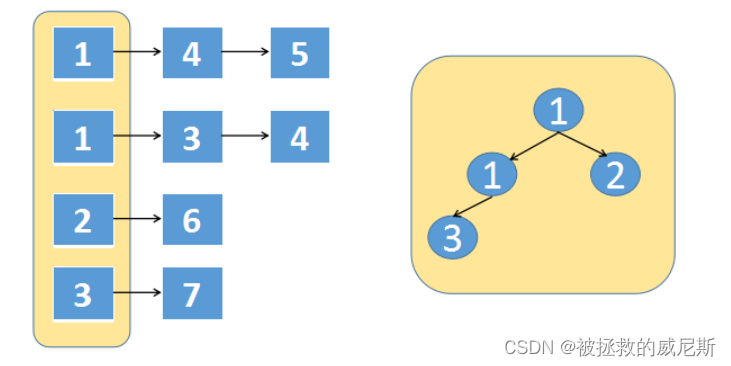
4个链表中的最小值,一定来自黄色的部分,黄色的部分就是一个小根堆。
这个堆的元素个数是k个,也就是图中的4个。
我们建立完k个大小的堆后,就不断的从堆中获取节点,如果获取到的节点不为空,即还有下一个节点,那么就将下一个节点放到堆中。利用这个特点我们就可以优化空间了,将原先的O(N)的空间复杂度优化到O(k)。
这种场景就好像就是4个售票窗口(图中只有一个窗口,嗯,脑补下剩下三个。。。),4排队伍在排队买票,但是只有一个工作人员,第一个人拿到票后,后面的人往前走,工作人员继续处理。
动画

代码
class Solution {public ListNode mergeKLists(ListNode[] lists) {if(lists==null || lists.length==0) {return null;}//创建一个小根堆,并定义好排序函数PriorityQueue<ListNode> queue = new PriorityQueue(new Comparator<ListNode>() {public int compare(ListNode o1, ListNode o2) {return (o1.val - o2.val);}});ListNode dummy = new ListNode(-1);ListNode cur = dummy;//这里跟上一版不一样,不再是一股脑全部放到堆中//而是只把k个链表的第一个节点放入到堆中for(int i=0;i<lists.length;i++) {ListNode head = lists[i];if(head!=null) {queue.add(head);}}//之后不断从堆中取出节点,如果这个节点还有下一个节点,//就将下个节点也放入堆中while(queue.size()>0) {ListNode node = queue.poll();cur.next = node;cur = cur.next;if(node.next!=null) {queue.add(node.next);}}cur.next = null;return dummy.next;}
}
E09. 查找链表中间节点-Leetcode 876
例如
输入:[1,2,3,4,5]
输出:此列表中的结点 3 (序列化形式:[3,4,5])输入:[1,2,3,4,5,6]
输出:此列表中的结点 4 (序列化形式:[4,5,6])
- 偶数节点时,中间点是靠右的那个
解法:快慢指针,快指针一次走两步,慢指针一次走一步,当快指针到链表结尾时,慢指针恰好走到链表的一半
public ListNode middleNode(ListNode head) {ListNode p1 = head; // 慢指针,中间点ListNode p2 = head; // 快指针while (p2 != null && p2.next != null) {p1 = p1.next;p2 = p2.next;p2 = p2.next;}return p1;
}
E10. 回文链表-Leetcode 234
所谓回文指正着读、反着读,结果一样,例如
[1,2,2,1]
[1,2,3,2,1]
它们都是回文链表,不是回文的例子
[1,2,3,1] --反过来--> [1,3,2,1]
/*步骤1. 找中间点步骤2. 中间点后半个链表反转步骤3. 反转后链表与原链表逐一比较
*/
public boolean isPalindrome(ListNode head) {ListNode middle = middle(head);ListNode newHead = reverse(middle);while (newHead != null) {if (newHead.val != head.val) {return false;}newHead = newHead.next;head = head.next;}return true;
}private ListNode reverse(ListNode o1) {ListNode n1 = null;while (o1 != null) {ListNode o2 = o1.next;o1.next = n1;n1 = o1;o1 = o2;}return n1;
}private ListNode middle(ListNode head) {ListNode p1 = head; // 慢ListNode p2 = head; // 快while (p2 != null && p2.next != null) {p1 = p1.next;p2 = p2.next.next;}return p1;
}
优化后解法
public boolean isPalindrome(ListNode h1) {if (h1 == null || h1.next == null) {return true;}ListNode p1 = h1; // 慢指针,中间点ListNode p2 = h1; // 快指针ListNode n1 = null; // 新头ListNode o1 = h1; // 旧头// 快慢指针找中间点while (p2 != null && p2.next != null) {p1 = p1.next;p2 = p2.next.next;// 反转前半部分o1.next = n1;n1 = o1;o1 = p1;}if (p2 != null) { // 节点数为奇数p1 = p1.next;}// 同步比较新头和后半部分while (n1 != null) {if (n1.val != p1.val) {return false;}p1 = p1.next;n1 = n1.next;}return true;
}
E11. 环形链表-Leetcode 141
本题以及下题,实际是 Floyd’s Tortoise and Hare Algorithm (Floyd 龟兔赛跑算法)
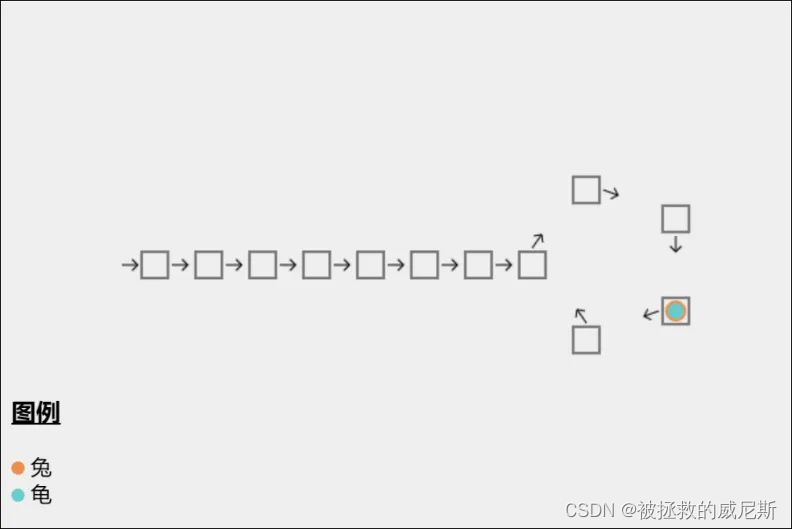
如果链表上存在环,那么在环上以不同速度前进的两个指针必定会在某个时刻相遇。算法分为两个阶段
- 龟一次走一步,兔子一次走两步
- 当兔子能走到终点时,不存在环
- 当兔子能追上龟时,可以判断存在环
参考代码
public boolean hasCycle(ListNode head) {ListNode h = head; // 兔ListNode t = head; // 龟while (h != null && h.next != null) {t = t.next;h = h.next.next;if(h == t){return true;}}return false;
}
E12. 环形链表-Leetcode 142
双指针的第一次相遇:
- 设两指针 fast,slow 指向链表头部 head 。
- 令 fast 每轮走 2 步,slow 每轮走 1 步。
执行以上两步后,可能出现两种结果:
第一种结果: fast 指针走过链表末端,说明链表无环,此时直接返回 null。
如果链表存在环,则双指针一定会相遇。因为每走 1 轮,fast 与 slow 的间距 +1,fast 一定会追上 slow 。
第二种结果: 当fast == slow时, 两指针在环中第一次相遇。下面分析此时 fast 与 slow 走过的步数关系:
设链表共有 a+b 个节点,其中 链表头部到链表入口 有 a 个节点(不计链表入口节点), 链表环 有 b 个节点(这里需要注意,a 和 b 是未知数,例如图解上链表 a=4 , b=5);设两指针分别走了 f,s 步,则有:
- fast 走的步数是 slow 步数的 2 倍,即 f=2s;(解析: fast 每轮走 2 步)
- fast 比 slow 多走了 n 个环的长度,即 f=s+nb;( 解析: 双指针都走过 a 步,然后在环内绕圈直到重合,重合时 fast 比 slow 多走 环的长度整数倍 )。
将以上两式相减得到 f=2nb,s=nb,即 fast 和 slow 指针分别走了 2n,n 个环的周长。
接下来该怎么做呢?
如果让指针从链表头部一直向前走并统计步数k,那么所有 走到链表入口节点时的步数 是:k=a+nb ,即先走 a 步到入口节点,之后每绕 1 圈环( b 步)都会再次到入口节点。而目前 slow 指针走了 nb 步。因此,我们只要想办法让 slow 再走 a 步停下来,就可以到环的入口。
但是我们不知道 a 的值,该怎么办?依然是使用双指针法。考虑构建一个指针,此指针需要有以下性质:此指针和 slow 一起向前走 a 步后,两者在入口节点重合。那么从哪里走到入口节点需要 a 步?答案是链表头节点head。
双指针第二次相遇:
- 令 fast 重新指向链表头部节点。此时 f=0,s=nb 。
- slow 和 fast 同时每轮向前走 1 步。
- 当 fast 指针走到 f=a 步时,slow 指针走到 s=a+nb 步。此时两指针重合,并同时指向链表环入口,返回 slow 指向的节点即可。
图示

参考代码(找到环入口)
public class Solution {public ListNode detectCycle(ListNode head) {ListNode fast = head, slow = head;while (true) {if (fast == null || fast.next == null) return null;fast = fast.next.next;slow = slow.next;if (fast == slow) break;}fast = head;while (slow != fast) {slow = slow.next;fast = fast.next;}return fast;}
}
E13. 共尾链表-Leetcode 160
原题叫做相交链表,个人觉得用共尾链表更形象些,此题更像是一道脑筋急转弯
例如,下图的两个链表 [1, 2, 4, 5] 与 [3, 4, 5] 它们中 [4, 5] 是相同的,此时应返回节点 4

非共尾的情况,如下图所示,此时返回 null

思路,称两个链表为 a=[1, 2, 4, 5],b=[3, 4, 5],图中用 N 代表 null
- 遍历 a,遇到 null 时改道遍历 b
- 与此同时,遍历 b,遇到 null 时改道遍历 a
- 在此过程中,如果遇到相同的节点,即为找寻目标,返回即可,如下图中的第二次出现的 4
- 相同节点应该比较其引用值,图中数字只是为了便于区分
1 2 4 5 N 3 4 5 N
3 4 5 N 1 2 4 5 N
如果两个链表长度相同,则可以更早找到目标,例如 a=[1, 4, 5],b=[3, 4, 5],第一次出现 4 时,即可返回
1 4 5 N 3 4 5 N
3 4 5 N 1 4 5 N
如果是非共尾的情况,如 a=[1, 2, 4],b=[3, 5],可以看到,唯一相等的情况,是遍历到最后那个 N 此时退出循环
1 2 4 N 3 5 N
3 5 N 1 2 4 N
代码
public ListNode getIntersectionNode(ListNode a, ListNode b) {ListNode p1 = a;ListNode p2 = b;while (true) {if (p1 == p2) {return p1;}if (p1 == null) {p1 = b;} else {p1 = p1.next;}if (p2 == null) {p2 = a;} else {p2 = p2.next;} }
}

